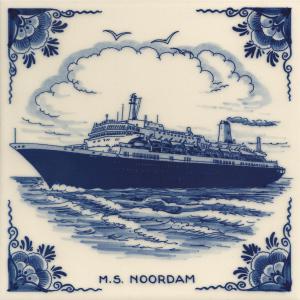Earlier Tiles
Little is known about the tiles from earlier years. Neither Holland America Line nor Royal Goedewaagen features archived documents certifying the origin. The only knowledge of 1910-1980 issued tiles is gathered on the basis of offered tiles for sale at auctions. The back of the tile usually offers the assurance that it actually concerns a tile that is issued by the Holland America Line. Unless stated otherwise, the format is 6″x 6″.
The assumed first known hand-painted tiles that were most probably issued by order of the Holland America Line are those of the ss Rotterdam IV (24.249 GT 1908-1940). This was the first ship of the company with a glass inserted promenade deck and cabins with private facilities. The tile on the left side is manufactured around 1910 by Plateelbakkerij Zuid-Holland in Gouda. The Ebay seller reported that the tile was found in the estate of his grandfather, an American soldier who fought in the First World War.
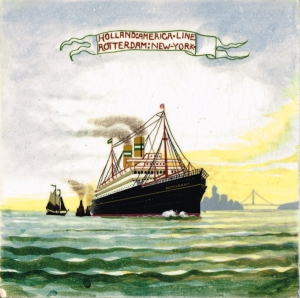
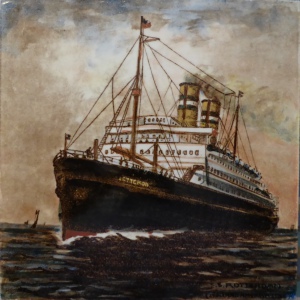
The tile on the right (7×7 inch) is not part of my collection. It was produced by Plateelbakkerij Rozenburg around 1920. I saw this tile in part 1 of the book “Lijnvaart in herinnering verankerd”, in which ship memorabilia from the glory years of the Dutch scheduled shipping are described and depicted. The scan I received from Willem Barten, one of the compilers of this book.
This tile (with a picture on both sides) is a 1913 Wedgwood Calendar Tile. The front reads “Pier 46 Mystic Wharves B.& M.R.R. Terminal, Boston 906 feet long 240072 square feet”. The steamer at the right is Holland America Line ss Amsteldijk I (1901-1924). These calendar tiles were created by Wedgwood Etruria England for the Jones McDuffee & Stratton Co Pottery Merchants, Boston, U.S.A. and given out each year. The tile is in great condition for its age (5.3″x 3.8″)
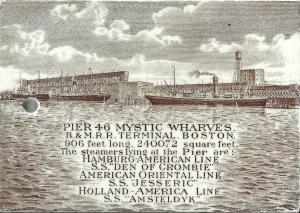

Tile tableau of the ss Ryndam I (1901-1929), built by Harland & Wolff in Belfast, Northern Ireland, United Kingdom. In 1918, the American government commandeered the ss Ryndam I to serve as a World War I troop transport ship. The not yet restored tableau (2 tiles of “6 x”6) is fixed to a wooden panel and is to be found in the extensive collection of Jaap van Dam from Bergen op Zoom, The Netherlands. Jaap is one of the top-3 collectors of Dutch Shipping, and is specialized in flat articles (such as prints, cards), mess-room porcelain crockery and original posters.
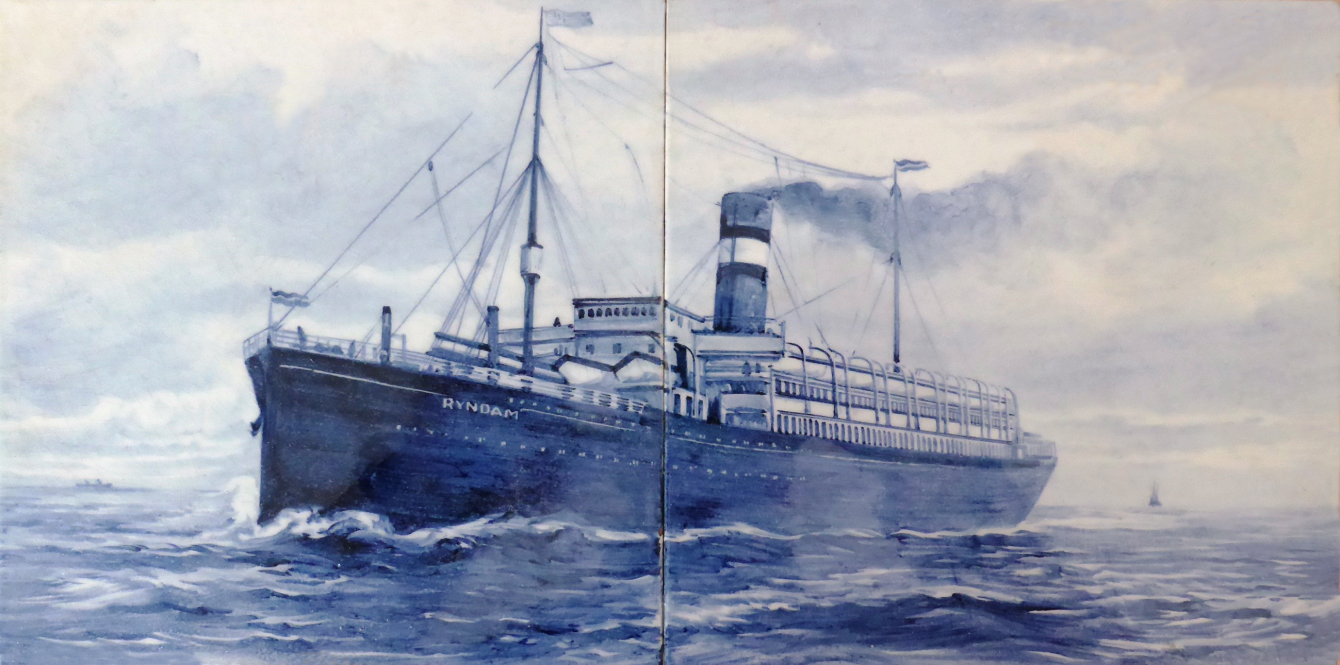
Recently the illustration of the below-placed, varied colored tile of the Halve Maen, has been found in the Royal Goedewaagen archive. This 6”x 6” tile has been drawn by Willem Hendrik van Norden (head of the Art department Goedewaagen-Distel at that particular time). One is assured that it concerns a Sphinx bisque painted tile from 1938, issued either on the ocassion of the launching of the ss Nieuw Amsterdam II, or on the ocassion of the 1939 World Exhibition in New York, where Royal Goedewaagen exhibited its wares. The signature on the side is interesting, and it is exceptional that there is a faulty date on the tile. Hudson sailed in 1609, not in 1604, to the river that would later bear his name.
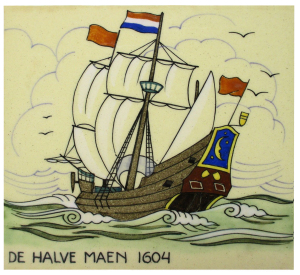
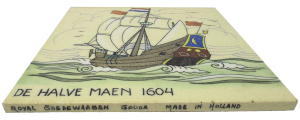
The Halve Maen was the sailing ship of the Dutch East India Company that, under the command of Captain Henry Hudson, entered the port of New York in September 1609. Until the summer of 2016 the Dutch origin lived on in the logo of the Holland America Line. The Halve Maen is depicted in the background of the bow of the Nieuw Amsterdam. Half Moon Cay, the private island of the Holland America Line, has been named after this ship. The link with HAL is reason to include Half Moon tiles in my collection
Six part tile tableau (6x 5″x 5″) painted at Tichelaar in Makkum in the second half of the 1930’s. According to the experts of Royal Goedewaagen, the tableau was painted by Jan Romke Steensma. The production was possibly directly related to the 1939 WorldExhibition in New York. A description of the tableau can be found in the menu News of June 1, 2020.
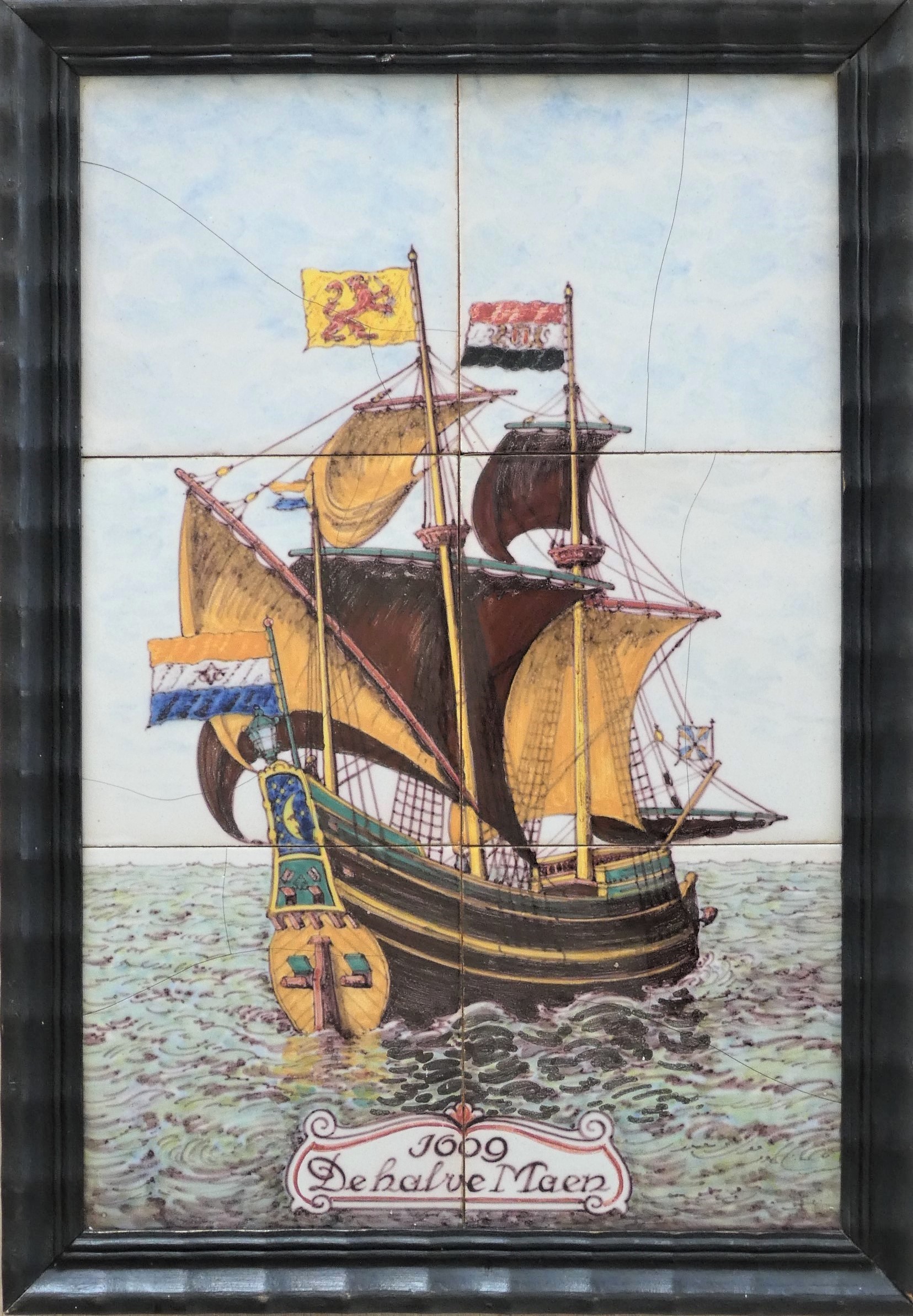
The cloisonné tile (8”x 5.5”) representing the Halve Maen is a design from Mar de Bruijn for Porceleyne Fles and was produced about 1950. The text on the reverse side states: “Henry Hudson’s Half Moon (1609)”; “with the compliments of Algemene Bank N.V. (General Bank of the Netherlands) Amsterdam”.
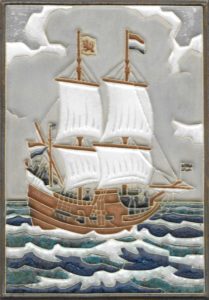
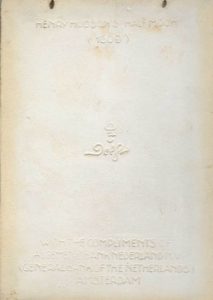
This tile is mentionned in the standard work “Dutch Tiles 1900-2000” from Jan Pluis and can also be found in the Dutch Tile Museum in Otterlo (see menu News).
Two cloisonné tiles of the Halve Maen, made in The Netherlands around 1950 by Westraven Utrecht, taken over in 1963 by Proceleyne Fles in Delft.
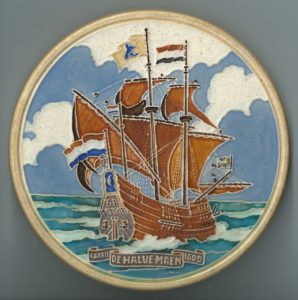


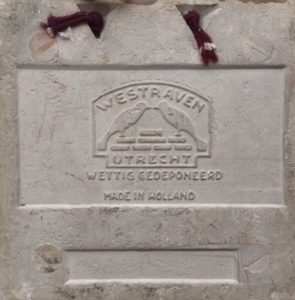
This tile is unique, it is an oxide pigment painted tile of the ss Statendam II. The ship was launched July 16, 1914. However, when England became involved in World War I on August 14, the ship was sold to the British government, painted grey and transformed to serve as a troop transport ship. The ship was given the name ss Justica and was torpedoed six times on July 19-20, 1918 and sank. See the menu News April 1, 2018.
According to the well renowned tile reference Nederlandse tegels 1900-2000 from tile specialist Jan Pluis, it concerns a biscuit tile from the MOSA factory made in 1945. The number 45 indicates the production year. The brand MMM, used between 1925 till 1949, stands for Muurtegelfabriek Mosa Maastricht. According to the specialists from Royal Goedewaagen it deals with a painting in the matt plateel- or Rhodian technique. First a glazing layer was applied to the biscuit tile which was fired at ~560 °C. Thereafter, an oxide pigment paint layer was applied and fired above 1000 °C.

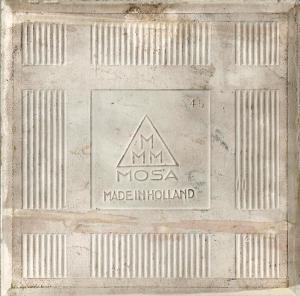
The Nieuw Amsterdam II (1938-1974), two times portrayed in enameled cloisonné on copper (4,7”x 3,2”), with and without the Holland America Line’s logo. According to curator Friggo Visser from the Keramisch Museum Goedewaagen there are indeed visual similarities with the cloisonné from Porceleyne Fles (see in this menu the large cloisonné tile from the sisterships Ryndam II and Maasdam IV), but in reality, it concerns the original Chinese technique from enamel on copper, apparently also applied in The Netherlands. Porceleyne Fles has confirmed not to be the manufacturer.
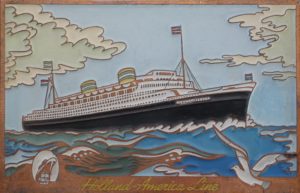
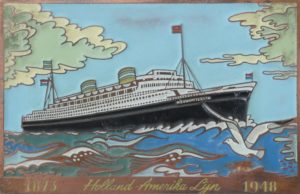
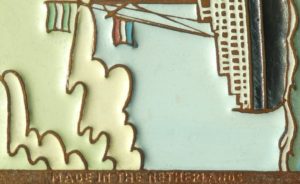
The enamel cloisonné on copper plaques were issued in 1948 on the occasion of the 75th anniversary of the Holland America Line, with as well as without the HAL-logo. They were most probably also mainly issued as a paperweight.
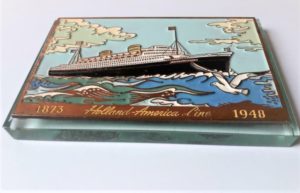
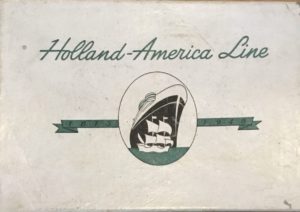
Two other editions in this series. Both the plaque of the Noordam II (1938-1963) and that of her sistership Westerdam I has also been issued as (glass) paperweight.
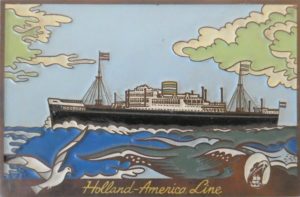
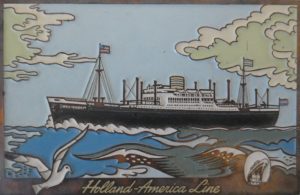
Tile tableau of the ss Volendam I (15.434 GT 1922-1952) that served as a troop transportship to and from Nederlands Indië (former Dutch Indies) after World War II. The tableau (six tiles 6″x 6″ each) was donated by the family Maten in 1949 “commemorating the homecoming with the ss Volendam from Indonesia”.

In the National Archives in The Hague I searched for the origin of the name “Maten” on this tableau. It is confirmed that the Volendam made two of these homebound trips, departing from Tandjong Priok on May 3 and October 30, 1949, arriving in Rotterdam on June 1 and November 28, 1949 respectively. However, the name does not appear on the passenger lists of the Volendam. So I must assume that the person for whom the tableau was intended, does not bear the name “Maten”.
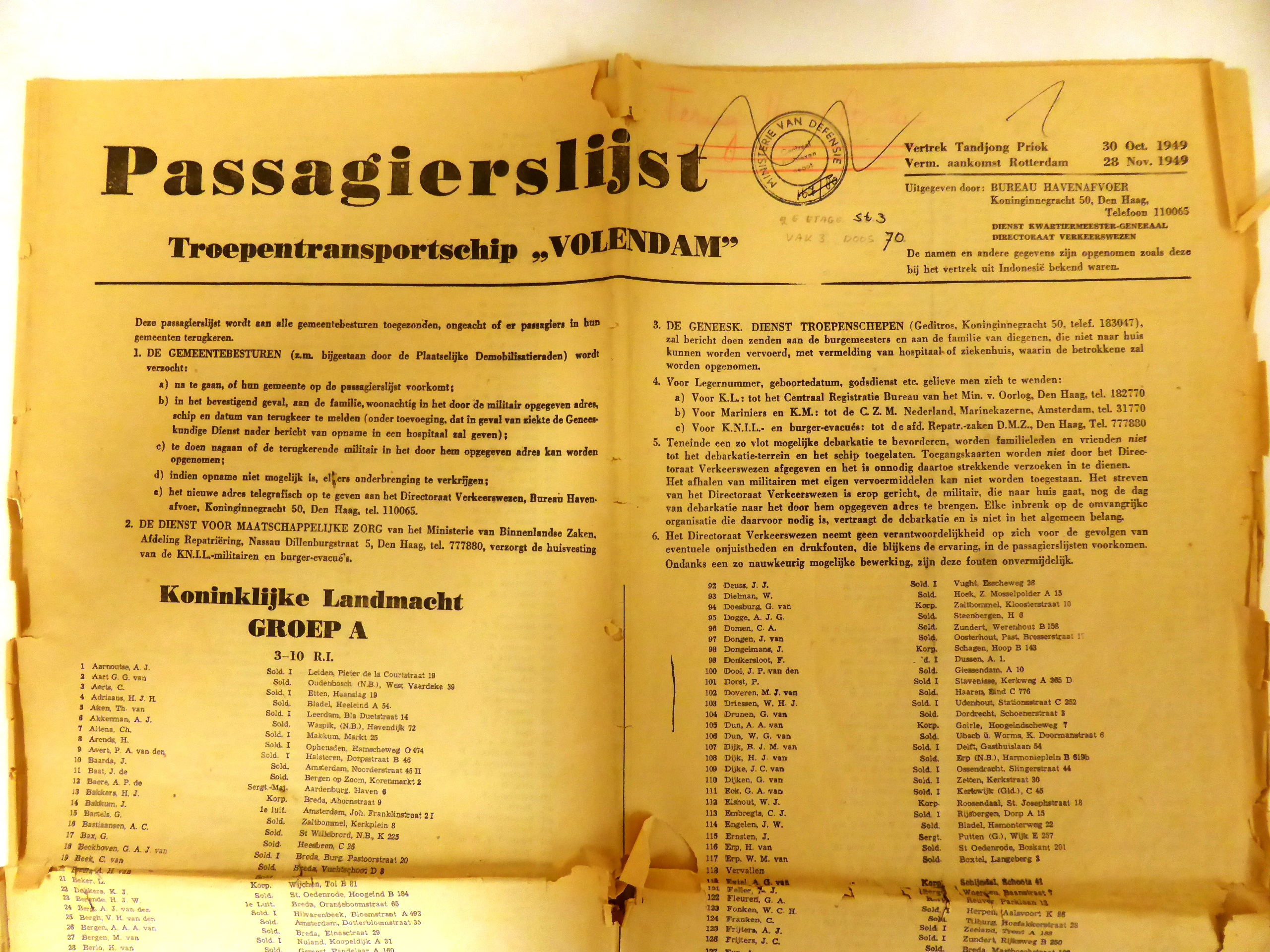

Via a passenger lists collector in Australia, I came into contact with Erik Abbenhuys in Melbourne, son of Ben Abbenhuys. Erik could not give me more information on the origin of the tile. Till now he was not aware of the existence of the tile. Unfortunately no further information could be obtained since both parents were deceased. Also the seller could not give further clarification. Ben Abbenhuys died on March 12, 2013.
Cloisonné tile (1952) of the sister ships ss Ryndam (1951-1972) and ss Maasdam (1952-1968), both built during the same time period by Wilton-Fijenoord in Schiedam. The tile (16″x 8″)was made by Porceleyne Fles. Cloisonné is a kind of enamel technique in which the surface decoration is set in hollows formed by thin strips of wire welded on a metal plate with the inner areas filled with color.


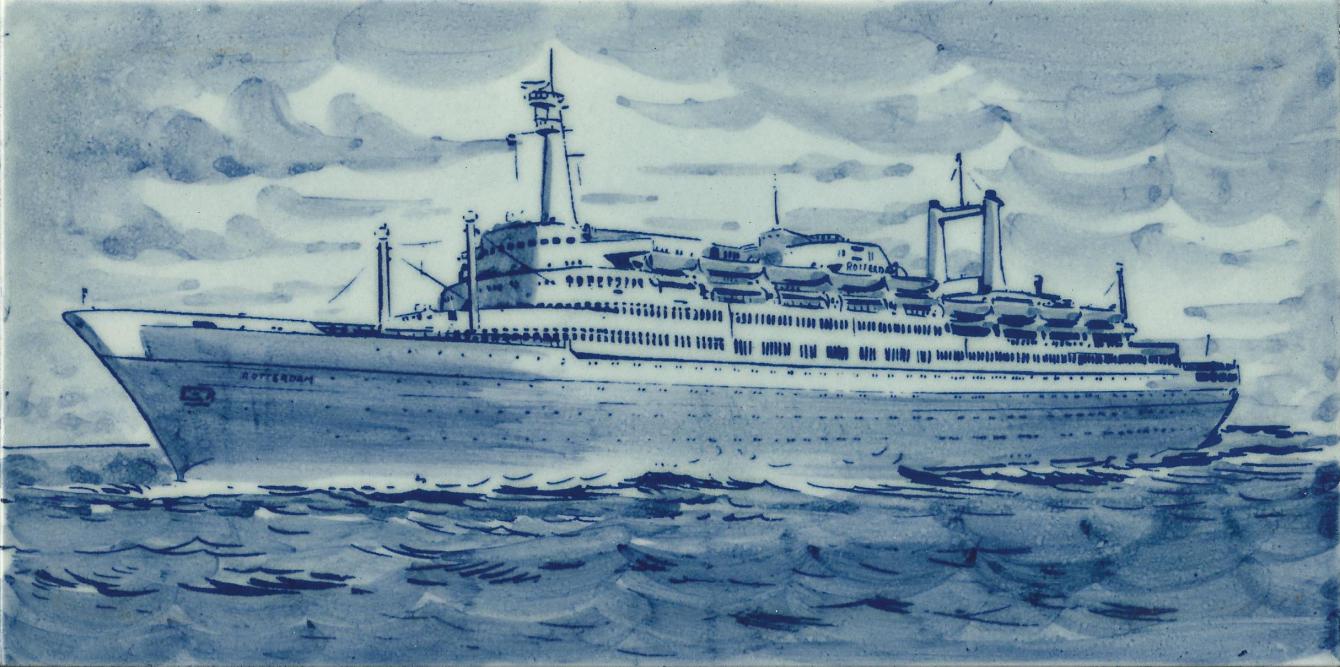
I received the tiles below from Klaas Krijnen, chairman of the foundation Behoud Stoomschip Rotterdam (Foundation for conservation of the ss Rotterdam). In the accompaning photo, one can see how the tiles with a tulip design were placed in the upper rim of the dividing screen between the tables back in the days in the Lido restaurant of the ss Rotterdam.
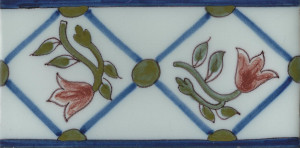

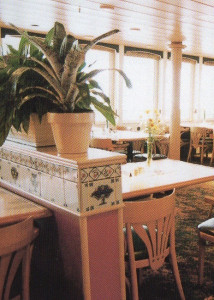
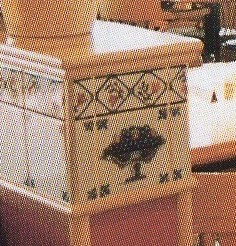
Tile of the ss Rotterdam V (4”x 4”), manufactured by the artist atelier Madi from Boskoop, The Netherlands in 1959, when the Rotterdam came into service. The Madi Boskoop firm was in operation from 1952 to 1993.
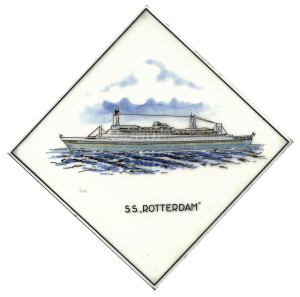
These three test tiles are made around 1960 in the Gouda pottery factory Zenith, assumed to be designed by Gerrit Piket. The factory developed from the pipes factory P.J. van der Want Azn and was in operation from 1749 until 1984. It is not known whether using these example loose tiles were ever manufactured. To my knowledge a singe tile out of this series is placed in a cheese platter. Considering the tekst “Holland Amerika Linie” it most likely concerns a German speaking commissioner.
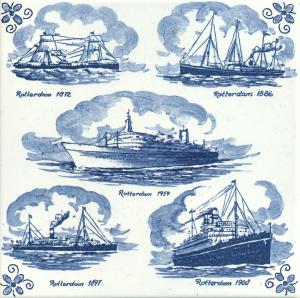
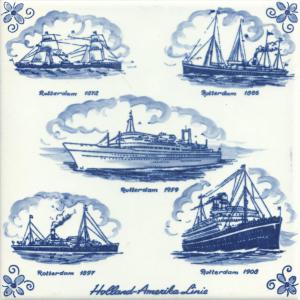
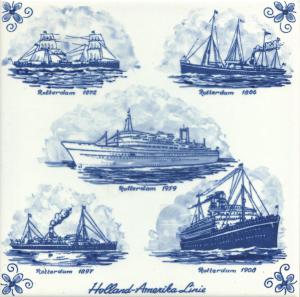
This hand-painted tile (8″x 4″) of the Nieuw Amsterdam II (launched in 1938 and with 35.000 GT at the time the largest Dutch ship) is in possession of the aforementioned Klaas Krijnen. The tile is designed by Gerrit Piket of the Gouda pottery factory Zenith, probably also the designer of the previously shown test tiles.

Another tile of the ss Nieuw Amsterdam II. The image is placed on a Mosa bisque by means of the transfer technique, using once fired yet unglazed and unpainted tiles. A similar tile of the ss Groote Beer has been introduced in the same series. Since this ship was sold in 1963, one can assume that the tile from the Nieuw Amsterdam dates from the early ’60. The tile was produced by the Bethlehem & Co firm from Rotterdam, at the time situated at the Lange Hilleweg in Rotterdam, The Netherlands. Information about this firm would be appreciated. All tiles in this series measure 8″x 4″.
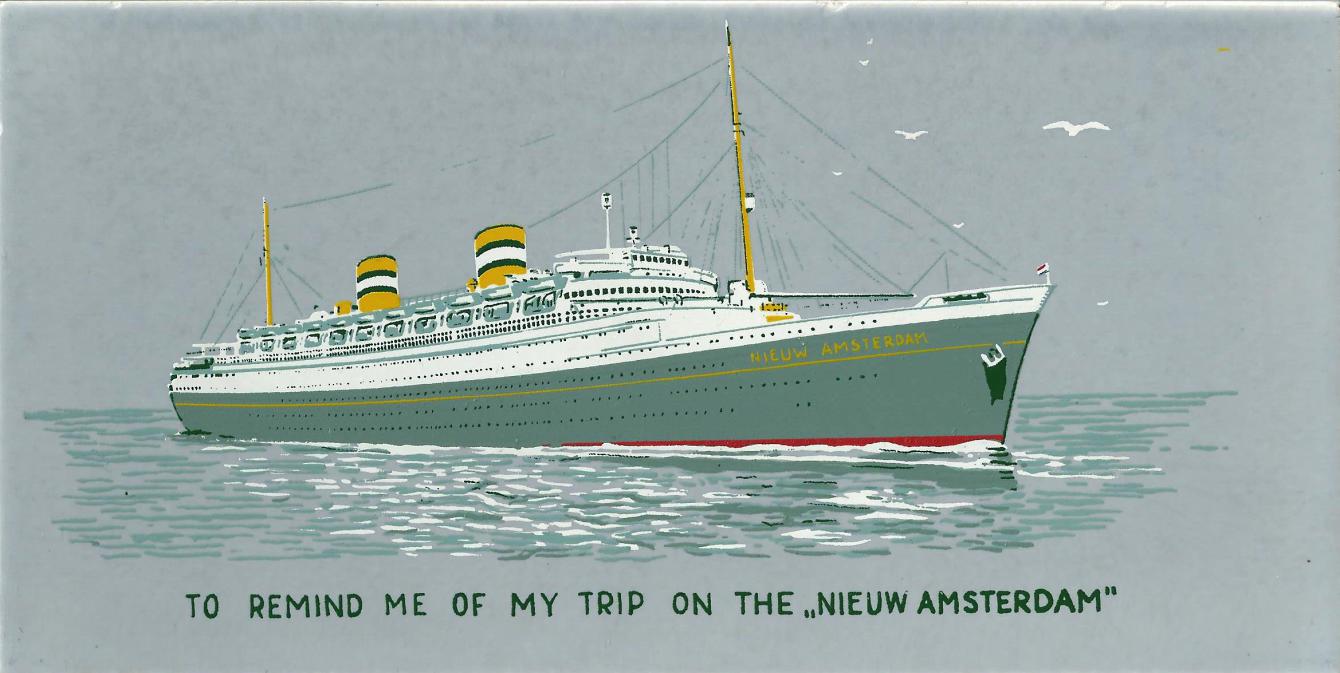
Tile of the ss Statendam IV (1957-1982). Again, this is an example of a picture being fixed by transfer technique on a bisque from Mosa.

Another tile made by Bethlehem & Co in Rotterdam. This time the tile of the ss Groote Beer. As explained in the menu Emigrant Ships, the Groote Beer was bought in 1947 by the Dutch government from the US War Shipping Administration and was managed by Holland America Line. Seeing that the Groote Beer was sold to a Greek shipping firm in 1963, one can assume that the tile also dates from the early ‘60. Indeed, the ship sailed under its old name Groote Beer in 1965 in a student exchange program involving 4 roundtrips from Rotterdam to New York; however, this concerned HAL charters. It can therefore be assumed that the tile was not distributed in relation to these trips.
Just as in the case of the other tiles in this series, the picture of the ss Groote Beer has been placed by means of transfer technique on bisque from Mosa. You can read more about this technique and the quality of the tile in the menu News (September 1 2016).

The fourth tile from the Bethelehem series is this tile of the ss Maasdam IV (1952-1968). It should not be ruled out that the tile of the ss Ryndam was also issued in this series since the ss Ryndam is the sister ship of the ss Maasdam. The tile is a gift from Joop Kap (deceased), former HAL-colleague and entrepreneur in Schiedam, The Netherlands, for which I am truly grateful.

The tile of the Maasdam IV (this time with inscription) is another tile from the Bethlehem series. As far as I know the series consists of 5 tiles.

The sixth tile from the Bethlehem series shows the ss Nieuw Amsterdam, this time issued in the post-war (1947-1956) colour black. It should not be ruled out that a tile of the ss Ryndam (1951-1972) was also issued in this series since the Ryndam was the sistership of the Maasdam. Information about the Bethlehem & Co firm, at the time situated at the Lange Hilleweg in Rotterdam, The Netherlands, would be appreciated.
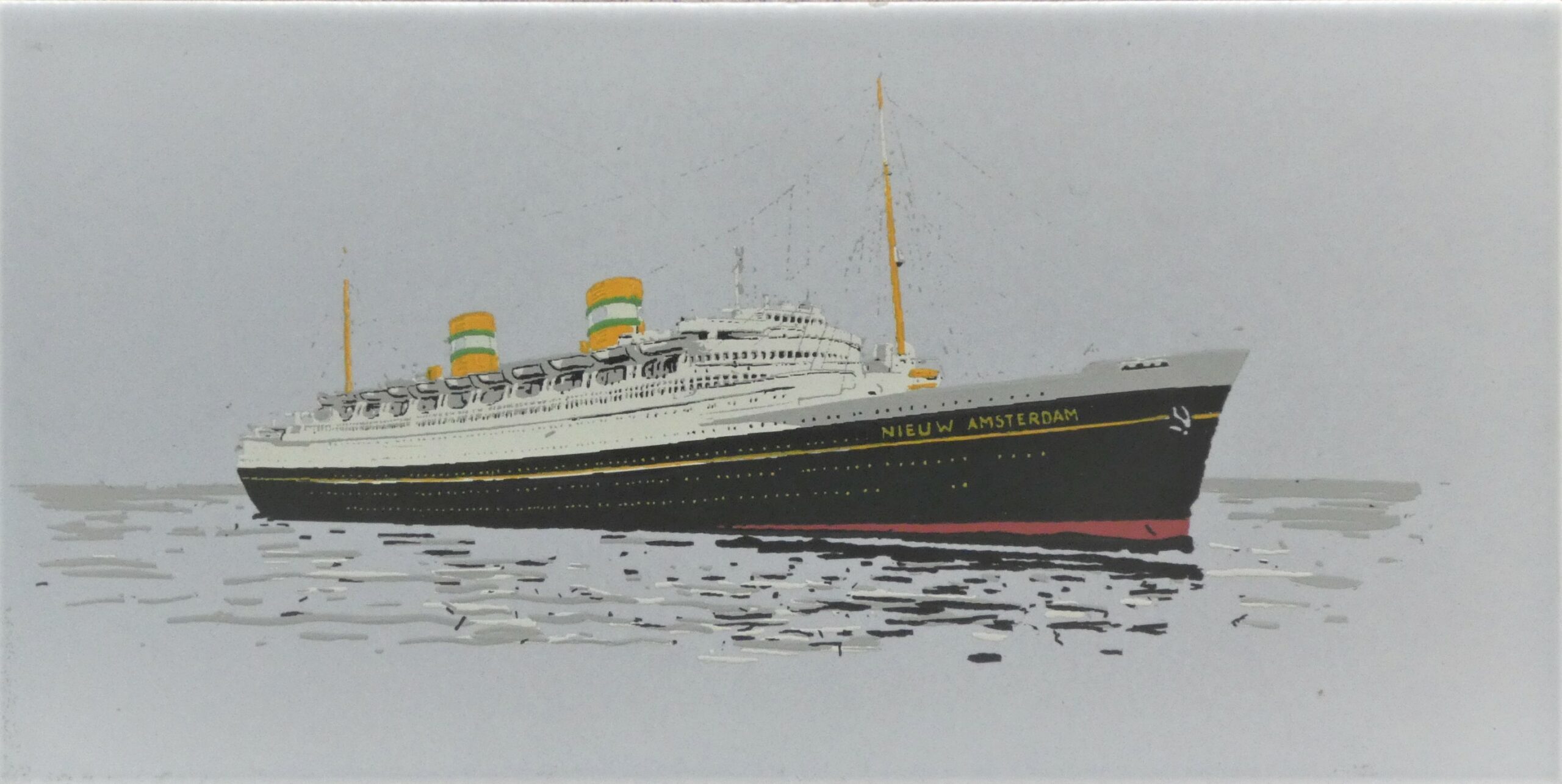
Hand-painted tile (6″x 3.3″) of the ss Nieuw Amsterdam II (1938-1974). The tile is a product of the Sport Club Nieuw Amsterdam, an organization that organized activities for crew members on board and in harbors. The confirmation thereof was given to me by my friend Ben van der Ent, formerly chef de rang (head diningroom steward) on the Nieuw Amsterdam, who during that time bought the souvenir spoon with the same S.C.N.A. notation (see menu News).

With the assistance of the tile specialists from the Goedewaagen Museum, the exact dating can be determined for this series of 8 tiles. The “blindmark” at the reverse side of the tile makes an exact dating possible; for example FE=1965, F=the sixties, E=the year. The Delft blue tiles, all produced on bisque from Sphinx, are designed by Piet de Jong, who was Goedewaagen’s headdesigner at that particular time.
The first two tiles were issued by the Holland America Line as a promotional gift in 1965. Probably a third tile would be part of this series, prominently displaying a windmill with two mills and a farm in the background. Up till now I have not seen a confirmation.


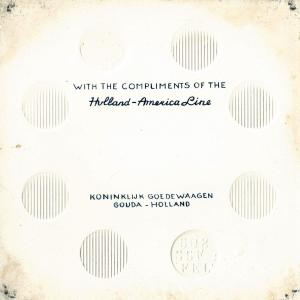
The tile of the “Strolling Couple” also has the code FE (1965)
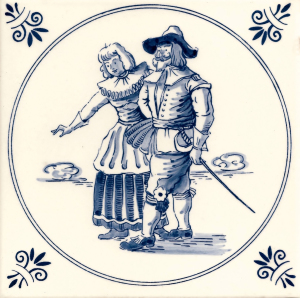

The first tile of the Halve Maen was made in 1968 (code FH). The second tile is a reprint and handed out in 1973 when Holland America Line was using the so called tri-wave logo. The tiles “Halve Maen” and “Strolling Couple” seem to belong together considering color, angel patterns and double striped curves in which the images are painted.
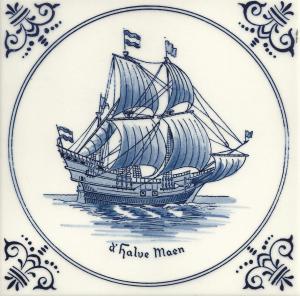
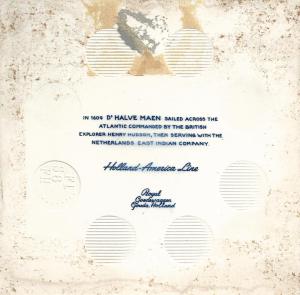


As mentioned above the Halve Maen was the sailing ship of the Dutch East India Company that, under the command of Captain Henry Hudson, entered the port of New York in September 1609. Until the summer of 2016 the Dutch origin lived on in the logo of the Holland America Line. The Halve Maen is depicted in the background of the bow of the Nieuw Amsterdam. Half Moon Cay, the private island of the Holland America Line, has been named after this ship. In the new logo the Halve Maen has been removed.
The “Fishseller” and “Boy at the Dike” (both 1968) also seem te come from the same series. The tiles have exactly the same corne pattern and also the curved surrounding in which the figures are depicted is identical. The backside of the tiles also indicate that the tiles are from the same series, considering the text and the placement thereof.
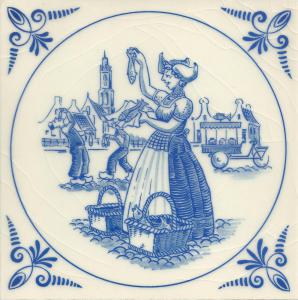
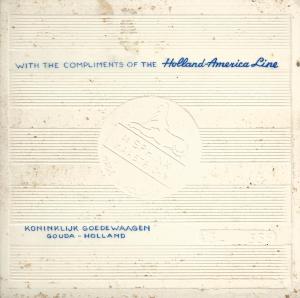
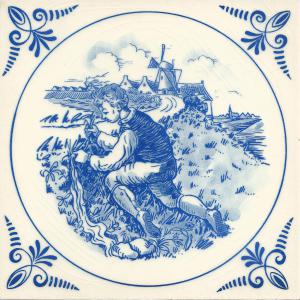
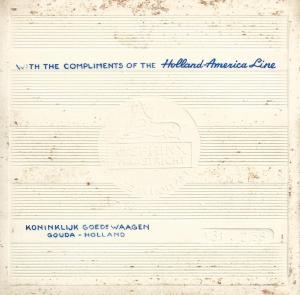
Threatening clouds, the wind blows tree branches to one direction, high waves and water flowing through the dike. The second tile seems to be inspired by the story of Hans Brinker, son of the lock keeper in Spaarndam, who sees a hole in the dike and protects the city against the rising water by sticking his finger into the hole.
The “Horseman” and “Tavern Scene” are currently the last known tiles from this period (1968). I have applied the protective cork layer on the backside (as done with the Mariner Collection tiles) to those tiles where the cork layer was missing.
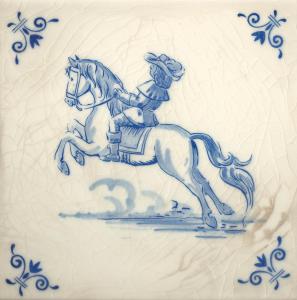
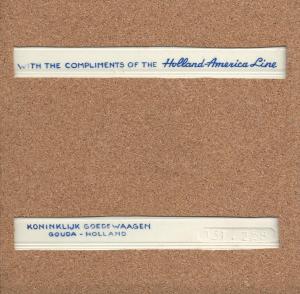
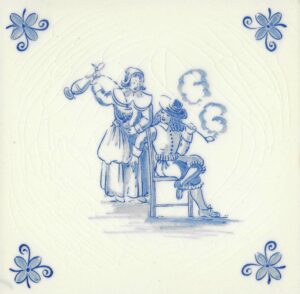
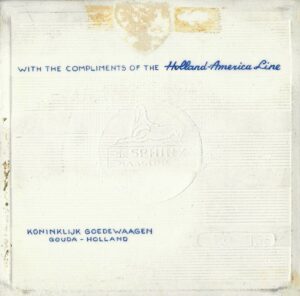
These three tiles were produced in the Danish ceramics factory Randers and were for sale on board the Nieuw Amsterdam in 1969. The tiles have gold-colored images against the jet-black background, which made it difficult for me to scan. Therefore they are photographed instead. The tile of the Nieuw Amsterdam was issued in the format 4.8″x 4.8″. The tiles of the Rotterdam and Statendam in 2.2″x 2.2″.
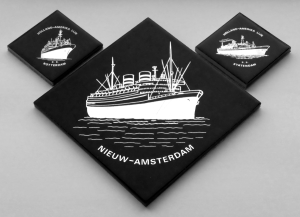
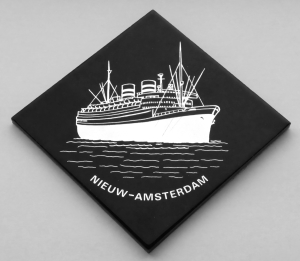
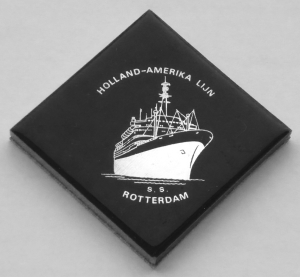
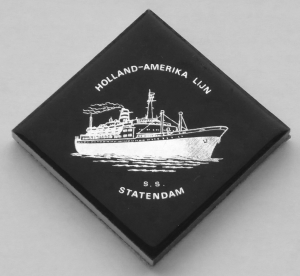
Two tiles of the Fall Mediterranean Discovery Cruise and one of the Spring Mediterranean Explorer Cruise of the ss Statendam in 1972. In cooperation with the Portuguese travel agent Marcus & Harting, HAL Shore Excursions surprised the passengers of the Statendam with these traditional hand painted tiles (3.1”x 3.1”) while visiting Lisbon. Most probably there is a fourth tile in this series. As far as I know only a blurry picture exists, copied out of a brochure. Information about this tile is most welcome. See the menu News June 8, 2018.
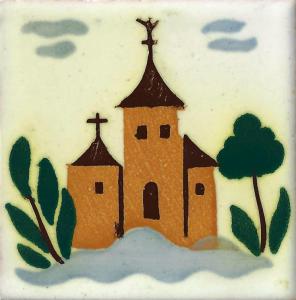
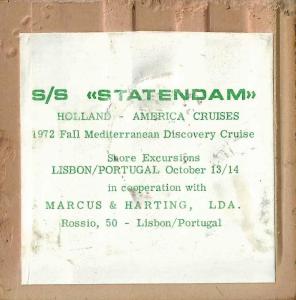
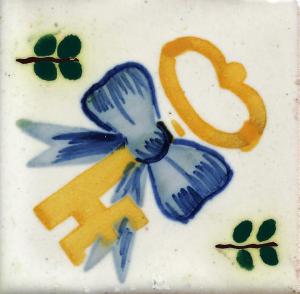
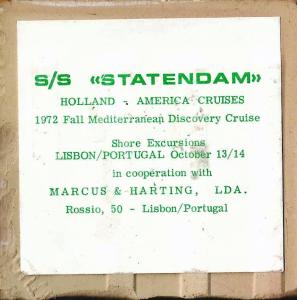


These tiles were distributed by Albert Vanderheide Publishing in Langley, British Columbia, Canada, as a by-product of editing the newspapers Hollandia News and The Windmill Herald. The exhibition of my tile collection (from July 9 till December 23 2016) has been visited by Ken and Carla Schmit from London, Ontario, Canada. In one of the display cabinets they saw the series of 12 tiles from Holland America Line emigrant ships. They recognized the tiles from the Groote Beer and Waterman, which are displayed in their own home. However, on those tiles an anchor is pictured, being the same anchor as on the tile of the ss Statendam IV, for which I mentionned before that the reason for the display of the anchor was unknown to me. This mistery is solved.
From correspondence with Albert Vanderheide it appears that the tiles with the anchor are distributed in 1978. The logos from the Albert Vanderheide Publishing edited newspapers are displayed within the anchor. The series from 12 (without anchor, see the menu Emigrant Ships) is a reprint, issued in 2000. The anchor logo has been removed in the reprint, since the publisher also received orders via internet from readers aside from regular subscribers.
As far as I know, the series with anchor currently consists of six tiles: the three emigrant ships Groote Beer, Volendam (I) and Waterman, and three non-emigrant ships Statendam (IV), Rotterdam (V) and Noordam (II).
Carla and Ken Schmit emigrated to Canada in the fifties, with the Waterman in 1953 and Groote Beer in 1954, respectively. Both tiles, which were displayed in their home for many years and from which they had many happy memories, were sent to me. A tremendous surprise for which I am genuinely grateful.
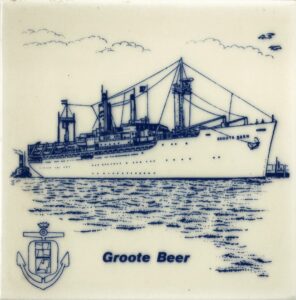
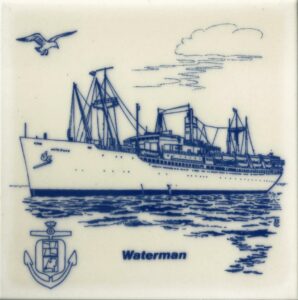
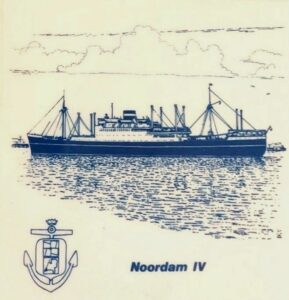
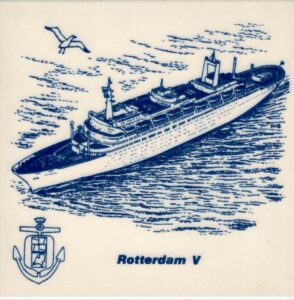
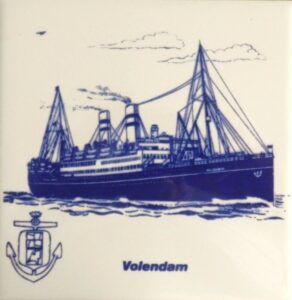
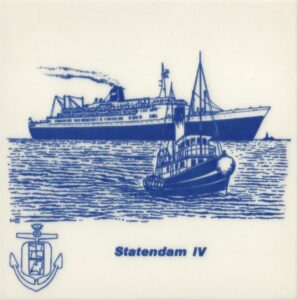
Two tiles with a departure scene at the Wilhelminakade in Rotterdam, at the time the Holland America Line homeport. The tiles were good for 500 new Windmill Herald and Hollandia News subscriptions (see the menu Emigrant Ships).
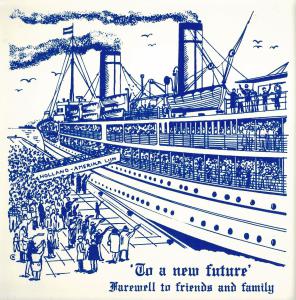
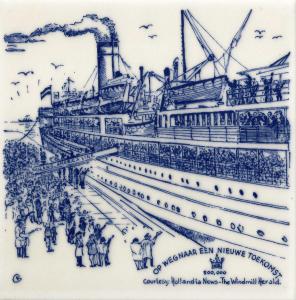
Chairman Klaas Krijnen of the Foundation Stichting behoud stoomschip Rotterdam sent me an image of three tiles that were intented for the interior of the Lido restaurant of the ss Rotterdam that was renovated in 1980. The foundation received these spare tiles as a gift from Daniel Blajan, who was security officer on the ss Rotterdam in 1979.
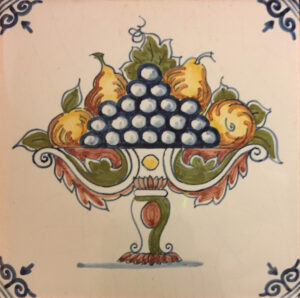
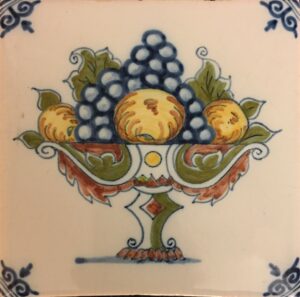

This tile is not issued by the Holland America Line, but made on board of the ss Rotterdam V during the 21st world cruise on February 14, 1981 (Valentine’s Day). The authenticity of the tile has been confirmed by former Chief Housekeeper Peter van den Bemt (deceased).
In 1981 Jan F. Swemmer from Hellevoetsluis (The Netherlands) was invited during the 21st world trip of the ss Rotterdam V to give a course in making ceramics. Here the product is shown that G. Shanus made on Valentine’s Day for his dear one. In order to show his gratitude to the company that funded part of this world trip, the ceramist donated a selfmade ashtray to the Chief Housekeeper (see the menu News September 1, 2018).
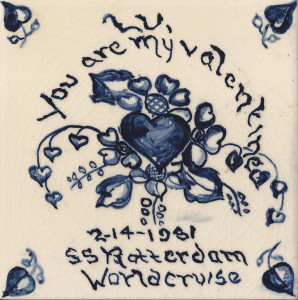
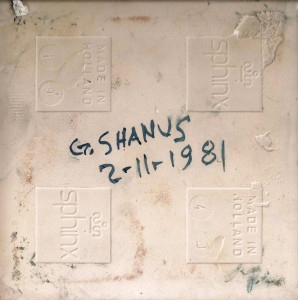
This unique tile tableau (four tiles 6″x 6″) from 1979 is designed by the same Jan F. Swemmer from Hellevoetsluis, The Netherlands. It seems that Adriaan (Arie) Struijk had sailed on the ss Nieuw Amsterdam in WW II and thereafter served as Laundry Manager on several world cruises on the ss Rotterdam. The tableau is part of the collection of Vereniging De Lijn.
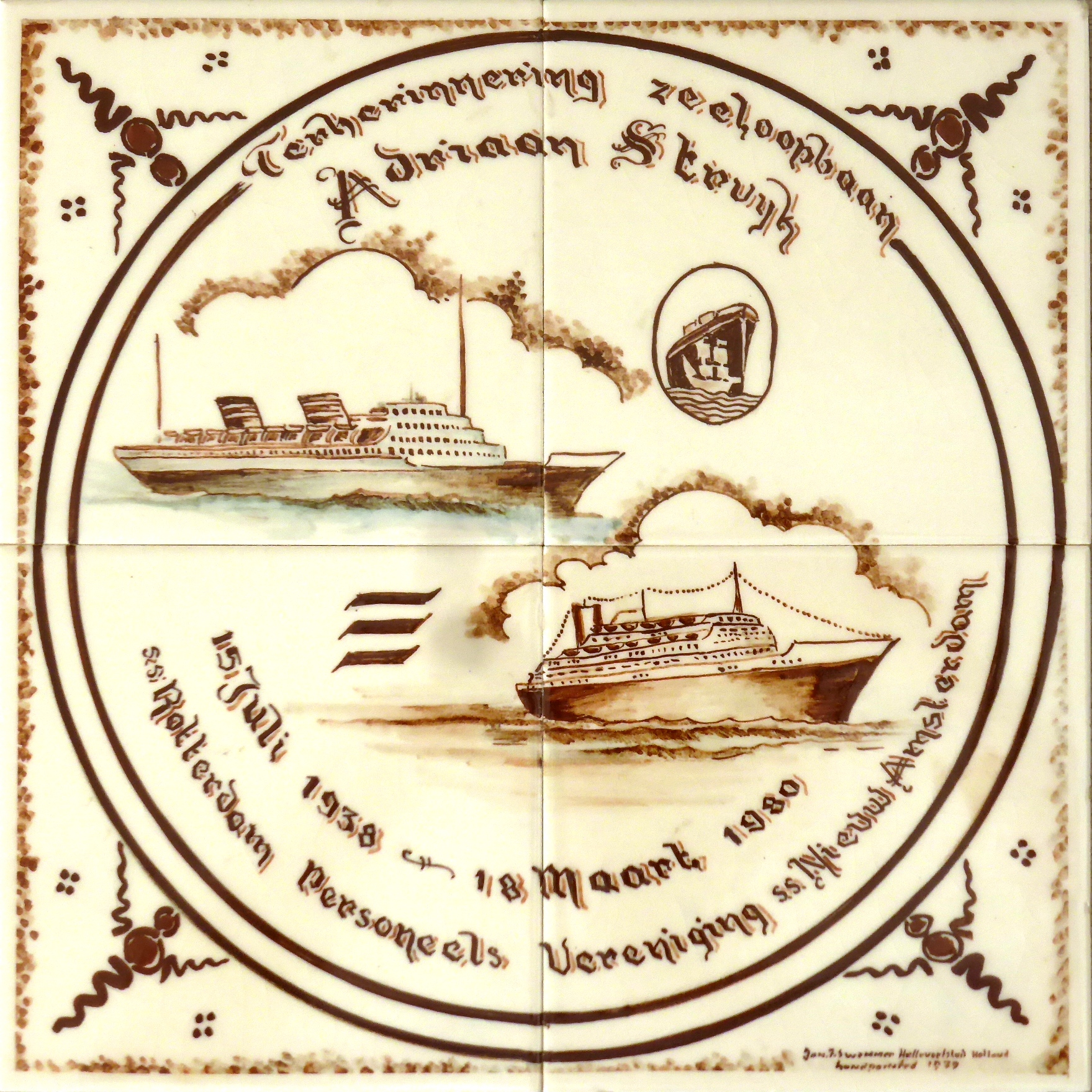
A second tile tableau from 1979, designed by Jan F. Swemmer. The tableau was presented to Janny Weggemans on the occasion of her promotion to (first female) purser at Holland America Line. The tableau is in possession of Vereniging de Lijn.
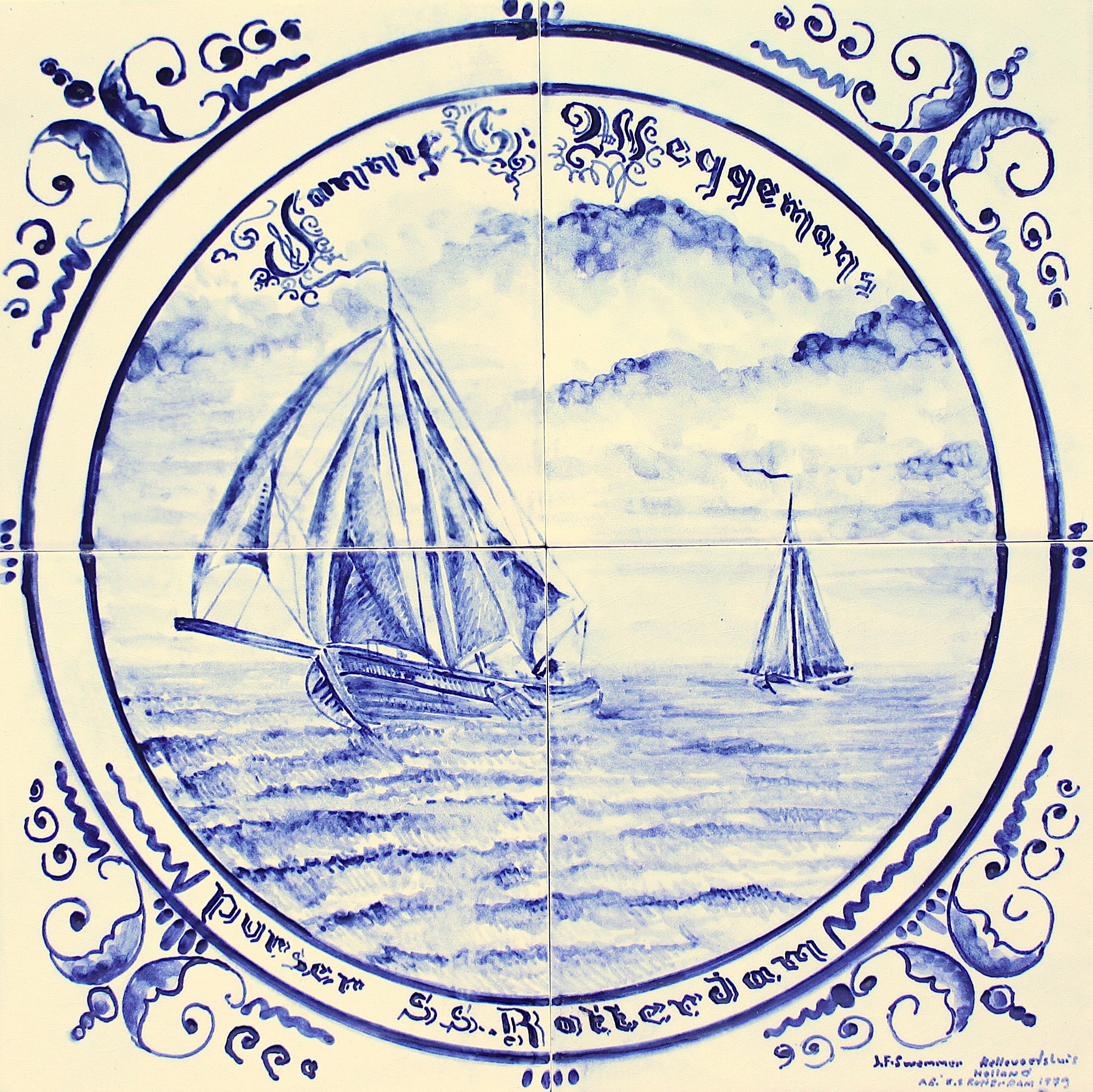
This two-part handpainted tile tableau of the ss Nieuw Amsterdam II (1937-1974 originates from the artist atelier De Leidsche Fles. The tiles measure 6″x 6″. The pottery painter is unknown to me. For the time being it is assumed that the tableau was produced when the ship went out of service. Any further information would be welcome.

The Netherlands was the first country to establish diplomatic relations with the USA. The first American ambassador, John Adams, who later became president, was received by the Dutch States-General on April 17, 1782. In recognition of the bicentenary diplomatic relations, this tile tableau (depicting the Nieuw Amsterdam II leaving the port of Rotterdam) was produced in 1982 by the pottery painter Nicolaas Koelewijn from the aforementioned artist atelier “De Leidsche Fles”. The framed panel, measuring 34″x 17″, consists of ten Delft blue tiles.

Tile panel (two tiles each 6″x 6″) of the ss Veendam III (1973-1984), former ss Argentina that was built in 1958 for the Moore-McCormack Lines. The panel is made in 1983 in The Netherlands by pottery ‘t Delftsche Huys (since 1981).

This hand painted tableau (1983, two tiles each 6″x 6″) of the ms Nieuw Amsterdam (III) is also manufactured in The Netherlands by pottery ‘t Delftsche Huys in Waddinxveen. The Nieuw Amsterdam is built in St. Nazaire in France, together with its sister ship ms Noordam (III).
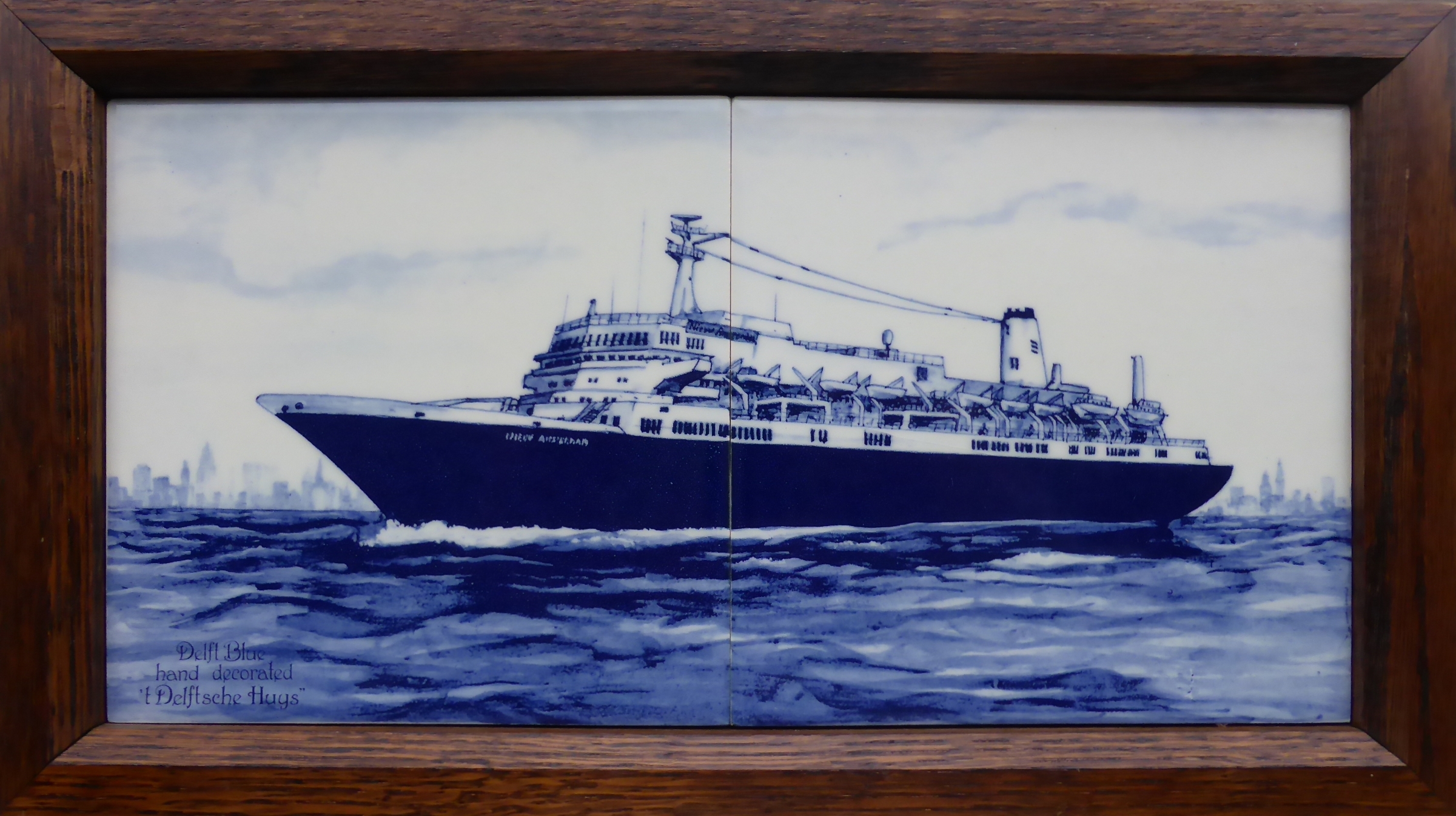
Another tableau (2 pieces 6″x 6″) of the ms Nieuw Amsterdam III (1983-2000). The tableau has no mark, but it is certain that it is also manufactured in 1983 in The Netherlands by pottery “t Delftsche Huys in Waddinxveen.

The tile tableau of the ss Veendam III (1973-1984), former ss Argentina that was built in 1958 for Moore-McCormack Lines, is also made in 1982 by pottery ’t Delftsche Huys. Until now I assumed that this factory produced three tile tableaus in the Holland Ameirca Line series, but is has now turned out that there are at least four.
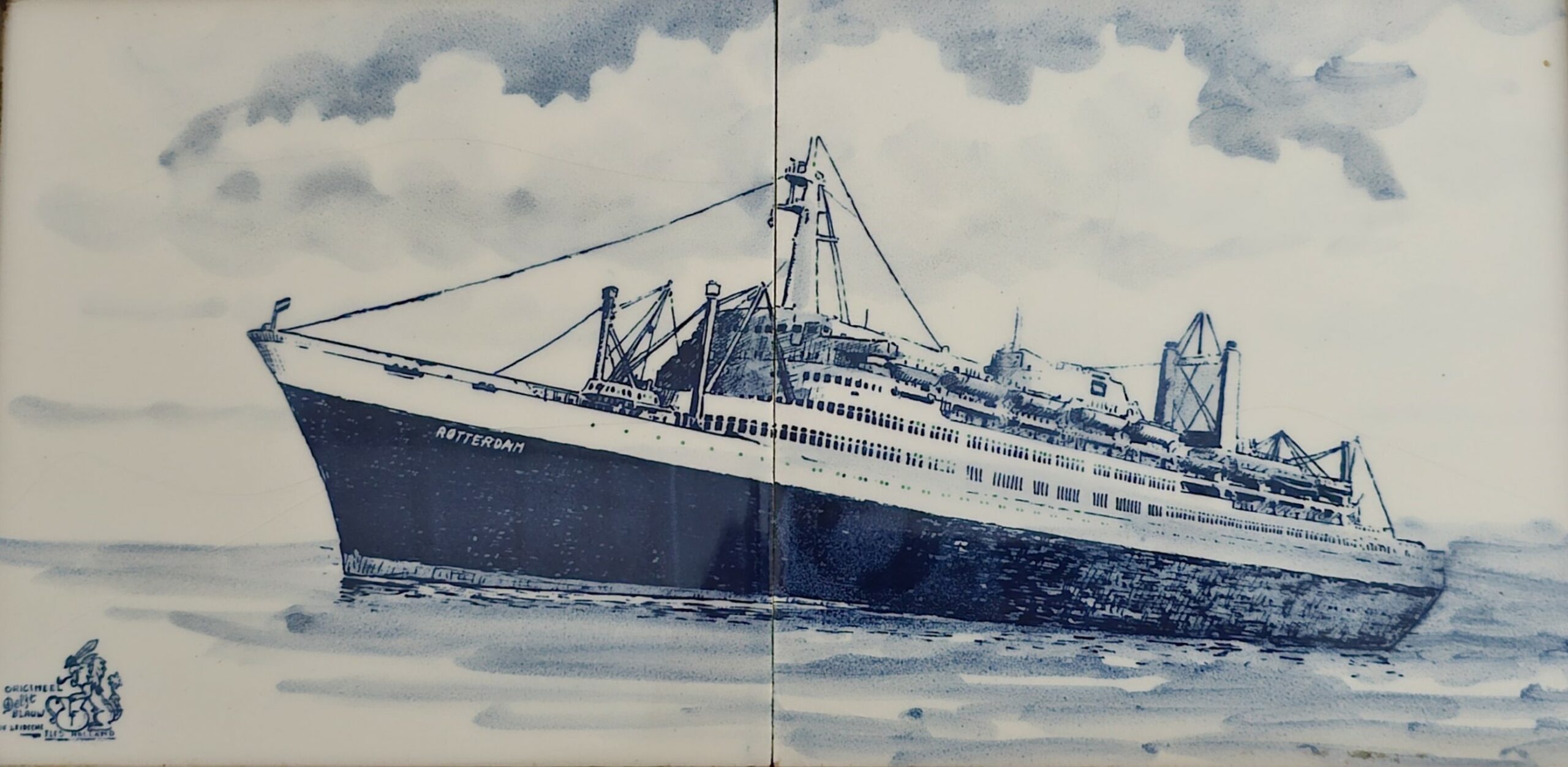
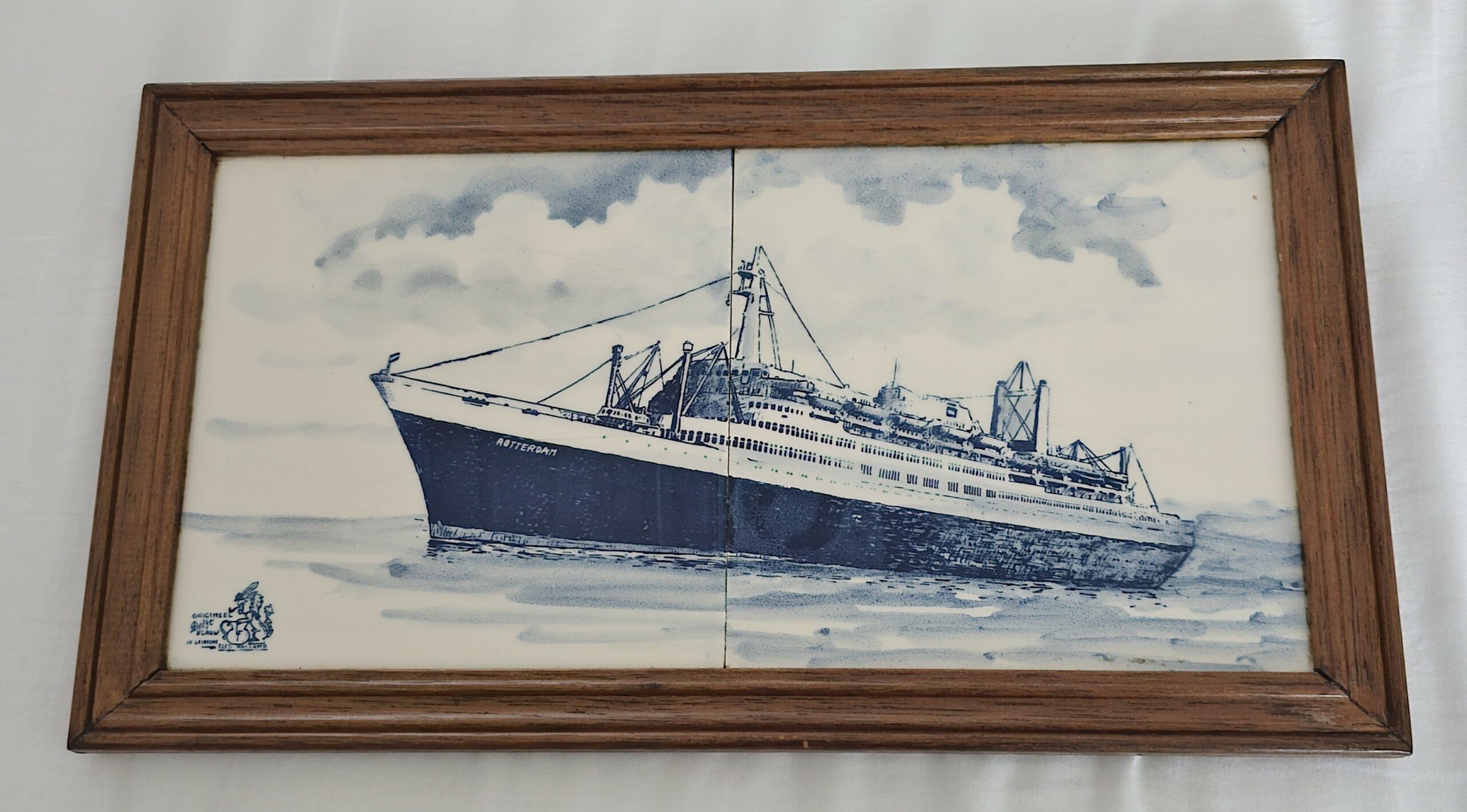
The tile of the Noordam III is part of a probable series of 3 tiles issued in 1984. The other tiles of this series are those of the ss Rotterdam V and the ss Nieuw Amsterdam III. The existence of those tiles has never been confirmed until now.
